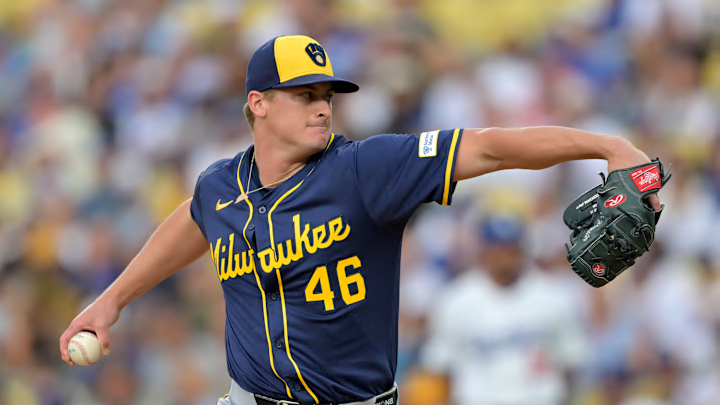With a 93 mph cutter perfectly placed just above the zone whiffed at by Los Angeles Dodgers' first baseman Freddie Freeman, Quinn Priester completed what was one of the most impressive first innings in recent memory. Not only did he strike out Freeman, but the Milwaukee Brewers' early-season trade acquisition struck out Mookie Betts and Shohei Ohtani in the previous two at-bats. That’s right, in the first inning of last night's win over the defending champions, Priester struck out three straight former MVPs in the opening frame.
Priester's strikeout parade didn't stop after the first inning; he went on to strike out 10 batters in last night's contest against one of the best offenses in baseball, including another three-strikeout frame in the bottom of the fifth. The 24-year-old right-hander has now cracked the 10-strikeout mark twice in his last four games. In that same span, Priester has collected three of his eight wins on the season; you have to go back to May 13 to find the last time that he took a loss in a start.
Simply put, Quinn Priester has been incredible over the last two months. On a micro level, it's an impressive turnaround from where his game was in early May, at which time he was sporting an ERA north of 5.00. On a macro level, Priester is revitalizing his entire MLB career with his performance in 2025. The former first-round pick was struggling to find success at the big league level, but a change of scenery and a new pitch have been integral to his success with the Crew.
Quinn Priester swapped his four-seamer for a cutter this season, the results have been eye-popping
The Brewers' pitching department has found incredible success tinkering with the pitch arsenals of the players that they bring into their organization. In particular, as of late, they have been successful when altering the fastball offerings of their pitchers. Even a proven veteran like José Quintana, who has been in MLB for 14 years, is throwing a significantly different mix of four-seamers and sinkers than he was before joining the Crew.
Priester has always relied heavily on his sinker, and he always should; it's an extremely effective pitch that holds a 63% ground-ball rate throughout his career. However, before joining the Brewers, Priester paired his sinker with a four-seamer. With below-average movement and velocity, Priester's four-seamer was killing him, as opposing hitters were slugging .667 on the pitch over the last two seasons. Additionally, the pitch wasn't unique enough from his sinker, as both pitches were running away from lefties or in on the hands of righties.
When he joined the Brewers, Chris Hook, Jim Henderson, and the rest of the Brewers' pitching staff encouraged him to add a cutter to his arsenal. The Boston Red Sox, the team Priester had been playing for, had the same thought, but shipped Priester to the Brewers before they could see it through. Priester obliged and essentially swapped his four-seamer for a cutter.
As Matthew Trueblood of brewerfantic.com explained in an article last week, Priester's cutter isn't anything special, but rather its value lies in how it impacts the rest of the pitches in his arsenal. Trueblood expertly breaks down how adding the cutter to his repertoire has allowed both Priester's slider and sinker to play up, using pitch recognition points from the hitter's perspective to visualize how Priester's offerings this year differ from what he was throwing in his previous two seasons. It's an awesome analysis from Trueblood; be sure to give it a read.
In addition to it helping his other pitches play up, taking the four-seamer out of the mix had been an "addition by subtraction" instance for Priester. When it comes to Stuff+, a metric that assigns a "score" to each pitcher’s individual pitches and then aggregates it to an overall score, Priester's worst pitch in each of the last two seasons was his four-seam fastball. It was the only one of his pitches that received a Stuff+ score below 80 (100 is league-average). Without the four-seamer in the mix, Priester's overall Stuff+ score for all of his pitches combined has jumped up seven points from a season ago, going from 91 to 98. Ironically, as Trueblood explained, his worst pitch this year according to Stuff+ is the cutter, with a score of 85, but Priester's sinker and especially his curveball are better than ever.
The result of having two fastballs that move in opposite directions, rather than two that broke arm side, is a sinker that appears to move more than it did in previous years, despite the pitch having almost identical metrics to last season. A season ago, the difference in horizontal break between Priester's two fastballs was 8.5 inches, according to Baseball Savant. Now, with the cutter replacing his four-seamer, the difference between his two high-velocity offerings is 15.5 inches.
Priester is striking batters out at a higher clip than he ever has throughout his MLB career. His 20.4% strikeout rate this year is a more than 5% improvement from last season. Of his 10 strikeouts against the Dodgers last night, four came on the cutter, and the other six came on Priester's sinker.
The rise of Quinn Priester has been a combination of expert scouting from the Brewers' front office, finding a player who had the tools for success but needed a few changes to his arsenal, continued excellence from Chris Hook and company, and a willingness to change and a dedication to his craft from Priester himself. All together, it makes for one of the best success stories of the 2025 season in all of Major League Baseball.
